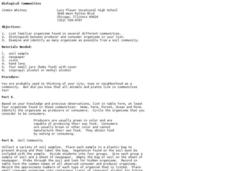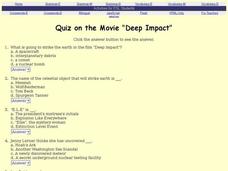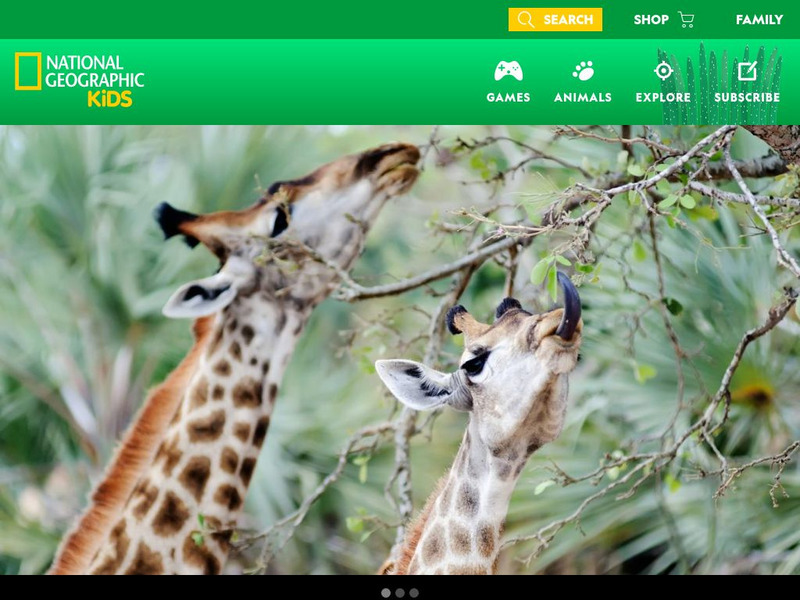Curated OER
Biological Communities
Pupils identify consumers and producers in different communities. Students collect a variety of soil samples and record organisms found in the samples.
Curated OER
Quiz: "Deep Impact"
In this "Deep Impact" quiz worksheet, learners answer a set of multiple choice questions about the film. Students may click on an "answer button for immediate feedback.
Curated OER
ESL-Homonyms #2
In this ESL homonym worksheet, students complete a set of 20 multiple choice questions, choosing the homonym that correctly completes a set of sentences. Worksheet is labeled as a quiz, but is appropriate for practice.
Curated OER
Nativity Play
Students participate in a play. In this Christmas lesson, students act out the Nativity. A game, a song, a craft, and a recipe are all included with the lesson.
Curated OER
Verbs
In this verbs worksheet, students read about verbs, then underline verbs in a set of 9 sentences and write 2 action verbs given people might do. Students then complete 2 alphabetical order activities.
Unite for Literacy
Unite for Literacy: Animals: Baby Animals
Can you name the babies of different animals? Includes audio narration in 18 additional languages with text in English.
Unite for Literacy
Unite for Literacy: Animals: First Steps
Read about the first steps taken by a baby Grevy's zebra. Includes audio narration in English, Spanish and Turkish, with text in English.
Unite for Literacy
Unite for Literacy: Animals: Red Robin
Read about an American robin and its baby birds. Includes audio narration in 6 additional languages with text in English.
abcteach
Abcteach: Animals
[Free Registration/Login Required] This link will place at your fingertips all kinds of resources for your science unit pertaining to animals such as birds, bugs, dinosaurs, endangered species, fish, mammals and reptiles.
E-learning for Kids
E Learning for Kids: Science: Rio De Janeiro: Animals and Their Babies
Join Emma and the children's carnival parade. Visit the zoo, and have a good look at the animals.
A-Z Animals
A Z Animals: Animal Facts: Skunk (Mephitis Mephitis)
Provides photographs and facts about the skunk. Discusses the different species, physical features, special characteristics of baby skunks, diet, behavior, the danger from cars, and reproduction.
Enchanted Learning
Enchanted Learning: Names of Animals, Babies, and Groups
Do you know what a baby elephant is called? How about the name for a group of gerbils? This site from Enchanted Learning provides information about male, female, baby, and group names of many animals. Click on the animal name to find...
Just Books Read Aloud
Just Books Read Aloud: Garth Williams: Baby Farm Animals
A video of the book "Baby Farm Animals", written by Garth Williams. Just Books Read Aloud is a site that includes children's books read aloud by normal (but enthusiastic) readers.
Other
Voice Thread: Baby Farm Animals
Narrated slideshow introduces viewers to a variety of baby animals and answers such questions as, what are baby goats called? what are baby cows called? what are baby swans called? [Registered users can comment on each slide, via text,...
National Geographic Kids
National Geographic Kids: Animals: Giraffes
This multi-media National Geographic site includes video and audio clips and fun facts all about giraffes. Students can even send a postcard to a friend.
Other
Illinois Department of Agriculture: Farm Animals and Their Babies
Click on the farm animals to learn what each animal baby is called. Includes animal sounds, and photos of mothers with their babies. Requires QuickTime Player for audio feature.
National Geographic Kids
National Geographic Kids: Animals: Komodo Dragon
Click-through facts-and-photo file about Komodo dragon characteristics, diet, and habitat. Includes a map of the country that pinpoints its range and a video that shows baby Komodo dragons hatching at the Denver Zoo.
Alabama Learning Exchange
Alex: Beanie Baby Habitats Collaborative Project
With the booming market of "Beanie Baby" type stuffed animals being so prominent in students' lives, this project brings that interest into the classroom through the use of research, science, hands-on experiences, and technology. The...
Other
Mammals and Their Babies
Twelve mammal baby pictures are displayed in this resource. If you roll your mouse over a picture you can see the adult version of the same animal.
McGraw Hill
Mc Graw Hill Education: Kindergarten: Activity Book [Pdf]
Help kindergarteners reinforce their knowledge of the alphabet and learn sight words with the activities in this 325-page book. This workbook is designed to supplement the following Big Books: Animals in the Park: An ABC Book by Bob...
San Diego Zoo Global
San Diego Zoo: Koalas
This resource presents detailed information about the koala, including several photos and a video clip. [0:12]
PBS
Pbs Learning Media: On Human Cloning
Three cloning experts share their opinions of cloning in these interviews from NOVA: "18 Ways to Make a Baby."
Globio
Glossopedia: Seals
Seals are mammals that live parts of their lives on land and other parts entirely in the water. They breed and care for their babies on land, but spend most of their lives in the ocean. This article provides an in-depth look at these...
Text Project
Text Project: Fyi for Kids: Standing on Your Own [Pdf]
This FYI for Kids (Volume 4, Issue 3) article discusses how babies both human and some animals move around. It includes humans, kangaroos, anteaters. wolf spiders, cows, and cichlids.





















![Mc Graw Hill Education: Kindergarten: Activity Book [Pdf] eBook Mc Graw Hill Education: Kindergarten: Activity Book [Pdf] eBook](https://content.lessonplanet.com/knovation/original/18006-d2b71b8c23f6d96172f01cb23d56dae7.jpg?1661551619)

